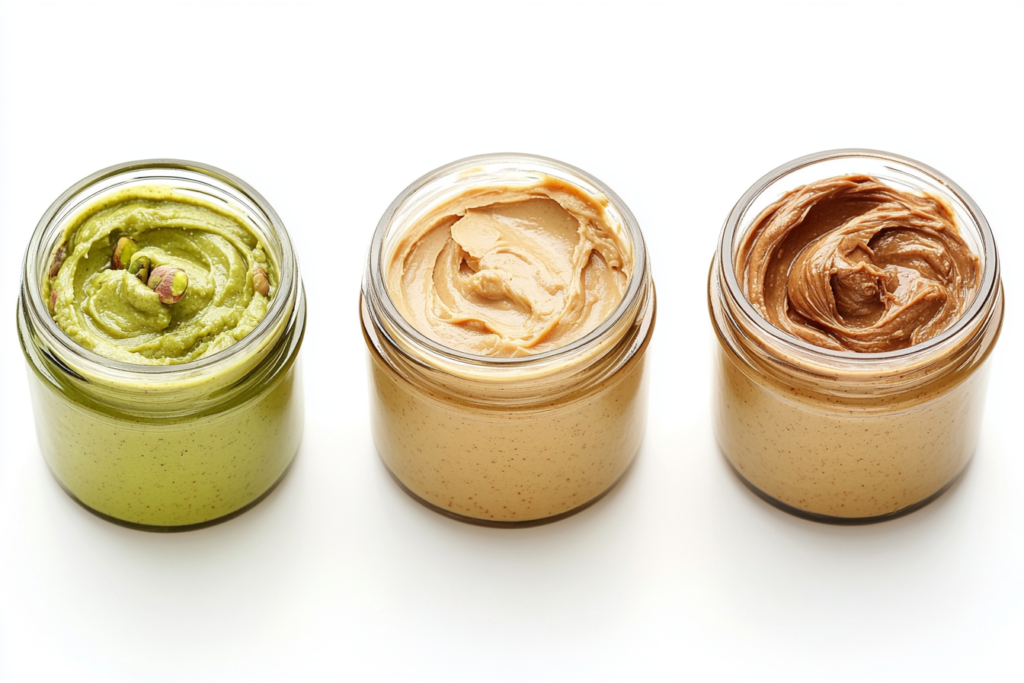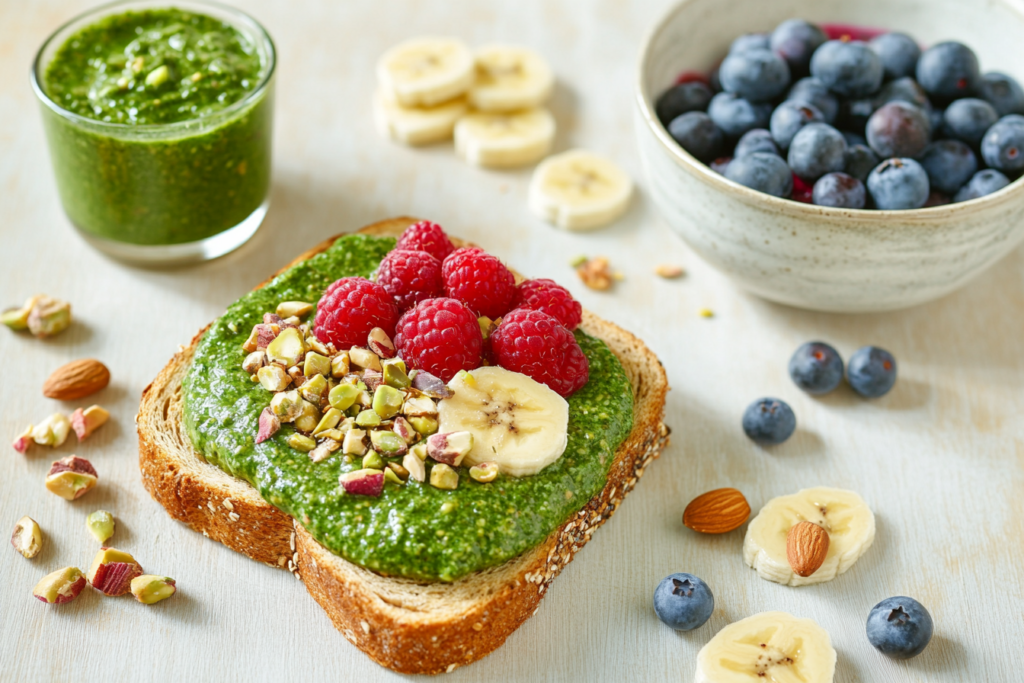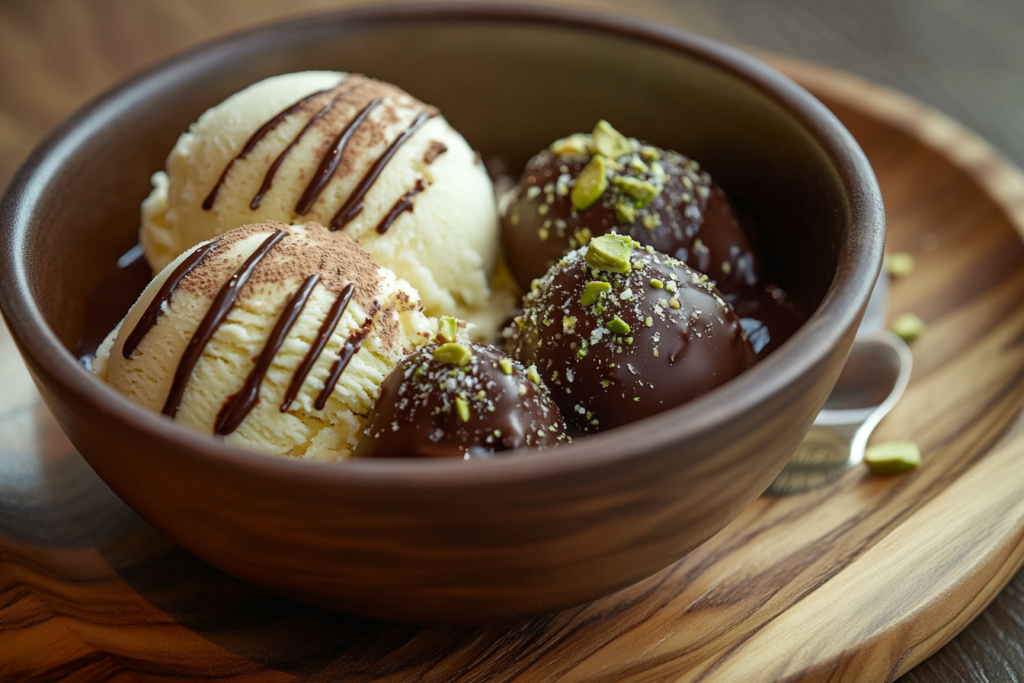If you’re anything like me, you’ve probably wandered down the nut butter aisle and noticed pistachio butter nestled among the almond and peanut varieties. Its creamy texture and rich, nutty flavor might be enough to tempt you, but have you ever stopped to ask yourself, how healthy is pistachio butter? Let’s take a deep dive into the world of pistachio butter and uncover everything from its nutritional benefits to potential drawbacks. Spoiler alert: it’s more than just a delicious spread!
Introduction to Pistachio Butter
What Is Pistachio Butter?
First things first—what exactly is pistachio butter? Simply put, it’s a creamy spread made by blending pistachios until they release their natural oils, creating a smooth and rich paste. Unlike peanut or almond butter, pistachio butter has a bold, nutty flavor and a bright green color. It’s often enjoyed in desserts, drinks, or simply spread on toast. But how healthy is pistachio butter, really?
Pistachio butter isn’t a new idea, though. People have been eating pistachios for thousands of years in the Middle East, and turning them into butter is a modern twist on an old favorite. Over time, it has become more popular, especially among those looking for healthy and flavorful alternatives to regular spreads.
Nutritional Composition of Pistachio Butter
One of the reasons pistachio butter is so talked about is its impressive nutritional profile. Let’s break it down:
Macronutrients and Micronutrients
Pistachio butter is a fantastic source of healthy fats, protein, and carbs. A typical serving (about 2 tablespoons) contains:
- Healthy Fats: Pistachio butter is rich in monounsaturated fats, the same heart-friendly fats found in olive oil. These fats help reduce bad cholesterol levels and support brain health.
- Protein: It boasts around 6 grams of protein per serving, making it a great choice for muscle repair and satiety.
- Carbs: With approximately 8 grams of carbohydrates, it provides a quick energy boost without spiking blood sugar levels.
It’s not just about macronutrients, though. Pistachio butter is loaded with essential vitamins and minerals, including:
- Vitamin E: Known for its antioxidant properties.
- Vitamin B6: Helps with brain function and mood regulation.
- Magnesium: Supports bone health and muscle function.
- Potassium: Aids in maintaining healthy blood pressure.
Calories in Pistachio Butter
Now, let’s talk about the big issue—calories. While pistachio butter is high in calories, with about 180-200 per two tablespoons, don’t let that worry you. In fact, these are nutrient-packed calories that, when eaten in moderation, can fit perfectly into a balanced diet.
Nutrition Facts Table: Pistachio Butter (Per 2 Tbsp Serving)
| Nutrient | Amount |
|---|---|
| Calories | 190 |
| Total Fat | 16g (10g monounsaturated) |
| Protein | 6g |
| Carbohydrates | 8g |
| Fiber | 3g |
| Vitamin B6 | 0.5mg (25% DV) |
| Magnesium | 35mg (9% DV) |
| Potassium | 290mg (6% DV) |
| Vitamin E | 2mg (10% DV) |
Health Benefits of Pistachio Butter
Now that we know what’s inside pistachio butter, let’s talk about what it can do for your body. Spoiler: it’s not just tasty—it’s packed with perks for your health!
Impact on Heart Health
One of the key benefits of pistachio butter is its heart-friendly properties. For example, the healthy fats in pistachios not only lower bad cholesterol (LDL) but also increase good cholesterol (HDL). As a result, this helps reduce the risk of heart problems and keeps your heart working well. Overall, it’s a delicious and easy way to take care of your health!
Role of Antioxidants
Did you know pistachios are packed with antioxidants? Pistachio butter keeps these benefits, making it great for reducing stress in your body. It can slow aging, boost your immune system, and protect your skin. It’s like having a mini anti-aging secret in your pantry!
Pistachio Butter for Weight Management
Here’s a fun fact: eating fats doesn’t necessarily make you fat. In fact, the healthy fats and protein in pistachio butter can help you feel fuller for longer, reducing the chances of overeating.
High Protein Content and Weight Loss
Protein plays a crucial role in weight loss and muscle maintenance, and pistachio butter delivers a decent amount of it. Whether you’re looking to shed a few pounds or simply maintain a healthy weight, this spread can be a useful addition to your meals.
Potential Risks of Pistachio Butter
Like most things in life, even something as healthy as pistachio butter isn’t without its potential downsides. While it’s packed with nutrients and benefits, there are a few considerations to keep in mind before diving headfirst into your jar of pistachio goodness.
Allergies to Nuts
First and foremost, pistachio butter is not for everyone. If you or someone in your household has a nut allergy, it’s important to exercise caution. Nut allergies can range from mild reactions like itching and hives to severe ones like anaphylaxis. If you’re unsure about how your body will react to pistachio butter, consult a doctor or allergist before trying it.
Overconsumption and Weight Gain
Yes, pistachio butter is a nutrient-rich food, but it’s also calorie-dense. Eating it straight out of the jar (we’ve all been there) can quickly lead to consuming more calories than you intended. This can be problematic if weight management is one of your goals. Moderation is key!
How to Avoid Overconsumption:
- Stick to portion sizes: Measure out a serving size (around 2 tablespoons) rather than eyeballing it.
- Pair it with nutrient-dense foods: Spread it on whole-grain toast or dip apple slices into it for a filling snack.
- Use it as an ingredient: Incorporate pistachio butter into recipes where the amount is controlled, such as smoothies or energy balls.
By being mindful of how much you’re eating, you can enjoy pistachio butter without overdoing it.
How Pistachio Butter Compares to Other Nut Butters
If you’ve ever stood in the nut butter aisle feeling overwhelmed by the variety, you’re not alone. Almond butter, peanut butter, cashew butter… the options seem endless! So how does pistachio butter stack up against the competition?

Nutritional Comparison
Pistachio butter stands out in a few key areas when compared to its nutty counterparts:
| Type | Calories (2 tbsp) | Protein | Fat | Notable Nutrient |
|---|---|---|---|---|
| Pistachio Butter | 190 | 6g | 16g | Vitamin B6, Potassium |
| Almond Butter | 190 | 7g | 16g | Vitamin E |
| Peanut Butter | 190 | 8g | 16g | Niacin |
| Cashew Butter | 180 | 5g | 14g | Magnesium |
Pistachio butter shines with its high potassium and vitamin B6 content, making it a great choice for those looking to boost these nutrients in their diet. However, peanut and almond butters tend to be higher in protein, so if you’re specifically looking for a protein-packed option, they might edge out pistachio butter.
Taste and Texture
Let’s not forget about taste! Pistachio butter has a uniquely rich, nutty, and slightly sweet flavor that sets it apart. It’s a luxurious option, especially for dessert recipes or as a topping for yogurt and oatmeal. If you’re looking for something with a bit more pizzazz than traditional nut butters, pistachio butter is a clear winner.
Homemade vs. Store-Bought Pistachio Butter
Now that you’re sold on the idea of pistachio butter, you might be wondering: Should I make it at home or buy it from the store? Each option has its pros and cons.
Pros and Cons of Homemade Pistachio Butter
Pros:
- You control the ingredients: No added sugars, oils, or preservatives.
- It’s fresh and customizable: Add a pinch of salt, a drizzle of honey, or even a dash of cinnamon for a unique twist.
- Cost-effective in the long run: Buying pistachios in bulk can be cheaper than buying pre-made butter.
Cons:
- Time-consuming: Making pistachio butter requires a good food processor and some patience.
- Equipment: Not everyone has a high-powered blender or processor capable of achieving a smooth consistency.
How to Identify High-Quality Store-Bought Pistachio Butter
If you’re going the store-bought route, here are a few tips to ensure you’re getting the best product:
- Check the ingredients: Look for pistachio butter with minimal ingredients—ideally just pistachios and maybe a pinch of salt.
- Avoid added sugars and oils: These can take away from the natural health benefits.
- Look for certifications: Organic and non-GMO certifications are a plus, especially if you’re concerned about pesticides or additives.
Best Ways to Incorporate Pistachio Butter into Your Diet
Now that you’ve got your pistachio butter in hand, what’s the best way to enjoy it? The options are endless! Here are some ideas to get you started:
Breakfast Boosters

- Spread it on whole-grain toast and top with sliced bananas or strawberries for a nutrient-packed breakfast.
- Swirl it into your oatmeal or yogurt for a creamy, nutty kick.
- Use it as a base for smoothies. Combine it with frozen bananas, spinach, and almond milk for a green pistachio smoothie.
Snack Ideas
- Dip apple or pear slices into pistachio butter for a satisfying snack.
- Spread it on rice cakes and sprinkle with a bit of sea salt or cinnamon.
- Add it to energy balls or granola bars for an on-the-go treat.
Dessert Delights

- Drizzle it over vanilla ice cream or use it as a filling for crepes.
- Mix it into cookie or brownie batter for a unique twist.
- Pair it with dark chocolate for a decadent treat.
Sustainability and Ethical Aspects of Pistachio Production
While pistachio butter is a nutritional superstar, it’s worth considering the broader impact of its production on the environment and ethical farming practices. After all, making informed food choices isn’t just about what’s good for our bodies—it’s also about what’s good for the planet.
Environmental Concerns
Pistachios are generally considered a sustainable crop compared to other nuts, but there are still environmental factors to keep in mind.
- Water Usage
Pistachios, like all nuts, require significant water to grow. However, they are less water-intensive than almonds, making them a relatively eco-friendlier option. For example, almonds need about 1.1 gallons of water per nut, while pistachios require considerably less. This makes pistachio butter a more sustainable choice, particularly in water-scarce regions. - Climate Suitability
Pistachio trees thrive in arid climates and are often grown in regions where other crops might struggle. Their ability to withstand drought conditions can make them a more environmentally conscious choice compared to water-thirsty crops. - Farming Practices
Some pistachio farms use sustainable farming techniques, such as reducing pesticide usage and implementing soil health practices. When buying pistachio butter, look for products that highlight eco-friendly farming or certifications like “organic” or “sustainably sourced.”
Supporting Ethical Brands
Another factor to consider is how the pistachios are sourced. Ethical production ensures fair wages for farmers, sustainable farming practices, and environmentally friendly processing. To support ethical brands:
- Look for pistachio butter from companies that are transparent about their supply chain.
- Prioritize local or small-batch producers when possible.
- Check for labels like “Fair Trade” or “Non-GMO Project Verified.”
By choosing sustainable and ethical pistachio butter, you’re not just nourishing yourself but also contributing to a healthier planet and supporting communities.
Pistachio butter is not just a trendy spread; its unique nutritional benefits make it stand out among other nut butters. For a deeper understanding of how pistachio butter compares to its counterparts like peanut butter, check out the article “Is Pistachio Butter Better Than Peanut Butter? A Full Comparison!”. If you’ve ever wondered why this delicious spread comes with a higher price tag, you’ll find the surprising reasons detailed in “Why is Pistachio Butter So Expensive? Discover the Surprising Reason”. And for an all-encompassing overview of this creamy delight, don’t miss “The Ultimate Guide to Pistachio Butter”. Each of these articles complements the insights shared here and offers additional perspectives on pistachio butter’s health and culinary appeal.
Conclusion
So, how healthy is pistachio butter? The verdict is clear: pistachio butter is a nutrient-dense, versatile, and delicious addition to any diet. Its impressive nutritional profile, combined with its potential health benefits, makes it a standout choice among nut butters. Whether you’re looking to improve your heart health, incorporate more antioxidants into your diet, or simply enjoy a guilt-free indulgence, pistachio butter has you covered.
That said, it’s important to enjoy it in moderation and be mindful of potential allergies or overconsumption. And remember, by choosing sustainably sourced pistachio butter, you’re supporting not just your own health but also the health of the planet.
So go ahead—spread, drizzle, bake, or blend pistachio butter into your meals. Your taste buds and your body will thank you!
FAQs About Pistachio Butter
If you’re new to pistachio butter, you probably have a few questions. Let’s clear up some of the most common ones.
Is pistachio nut butter good for you?
Yes, pistachio nut butter is good for you. It’s packed with healthy fats, protein, fiber, and essential vitamins like B6 and E, making it a nutritious and heart-healthy choice when consumed in moderation.
What’s the healthiest nut butter?
The healthiest nut butter depends on your dietary needs, but almond, pistachio, and peanut butters are top contenders. Pistachio butter stands out for its antioxidants and lower calorie content compared to some other options.
Is pistachio butter bad for cholesterol?
No, pistachio butter is not bad for cholesterol. Its high monounsaturated fat content helps lower LDL (bad) cholesterol while increasing HDL (good) cholesterol, supporting heart health.
How much sugar is in pistachio butter?
The sugar content in pistachio butter varies by brand. Natural pistachio butter typically contains little to no added sugar, with only 1-2 grams of natural sugar per serving. Always check the label for added sugars.

